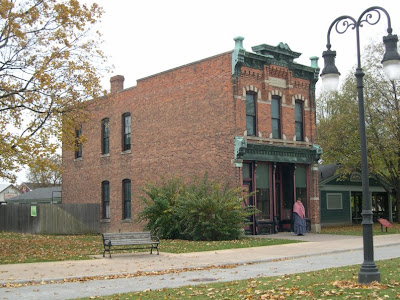Phoenixville Post Office (and Apothecary)
 From Phoenixville, Connecticut came the building, originally built in 1825, of the local apothecary. An apothecary was one that prepared and sold remedies and other medicinal treatments, not unlike our modern pharmacist. They would offer medical advice as well if no doctor was readily available. In early settlements whenever a settler fell ill and needed an immediate cure they headed for the apothecary shop where rows of drawers containing drugs made from roots, plants, berries and bark - often grown by the apothecary himself or collected from the countryside - lined the walls. And on shelves were bottles of nerve 'vitalizers,' heart remedies, rheumatic syrups, jars for leeches, and lung balm (among other things). The chemist would mix his cures right there inside this building.
From Phoenixville, Connecticut came the building, originally built in 1825, of the local apothecary. An apothecary was one that prepared and sold remedies and other medicinal treatments, not unlike our modern pharmacist. They would offer medical advice as well if no doctor was readily available. In early settlements whenever a settler fell ill and needed an immediate cure they headed for the apothecary shop where rows of drawers containing drugs made from roots, plants, berries and bark - often grown by the apothecary himself or collected from the countryside - lined the walls. And on shelves were bottles of nerve 'vitalizers,' heart remedies, rheumatic syrups, jars for leeches, and lung balm (among other things). The chemist would mix his cures right there inside this building. Apothecaries were not as knowledgeable as doctors and therefore would not charge as much as a doctor's pay. This being the case, there was no formal training to become an apothecary; they would take on an apprentice who would receive on the job training. Typical for an apprentice, they would begin their career doing the mundane jobs of sweeping and general cleaning of the shop, but eventually would graduate to the more important tasks of the profession.
Apothecaries were not as knowledgeable as doctors and therefore would not charge as much as a doctor's pay. This being the case, there was no formal training to become an apothecary; they would take on an apprentice who would receive on the job training. Typical for an apprentice, they would begin their career doing the mundane jobs of sweeping and general cleaning of the shop, but eventually would graduate to the more important tasks of the profession.This particular structure also became the town post office in November of 1850, run by Monroe Latham and his wife, Sarah. It remained an apothecary while serving as a post office.
 In the 19th century, mail delivery was quite different than today. Folks usually went to the post office to retrieve their mail rather than had it delivered, especially in the small, more rural towns. Because of the slow travel mode of the times, for a postmaster to deliver a letter to one of the many residents that lived a few miles out of town would take a day or more to deliver - hardly worth it for just one letter. It was much more convenient for patrons to visit the post office when visiting the town to get their provisions.
In the 19th century, mail delivery was quite different than today. Folks usually went to the post office to retrieve their mail rather than had it delivered, especially in the small, more rural towns. Because of the slow travel mode of the times, for a postmaster to deliver a letter to one of the many residents that lived a few miles out of town would take a day or more to deliver - hardly worth it for just one letter. It was much more convenient for patrons to visit the post office when visiting the town to get their provisions.When one of Henry Ford's assistants discovered the unused building (for it ended its use as an apothecary in 1910 and as a post office in 1916), the original furnishings of the post office (including the desk and even the waste baskets!) were still intact and brought to Dearborn with the building. Unfortunately, the bottles and equipment of the apothecary was no longer there and were added after the move.
Dismantling of this building began in 1928 and it was up in the Village, ready for October 21st, 1929 opening day.
.
.





Comments